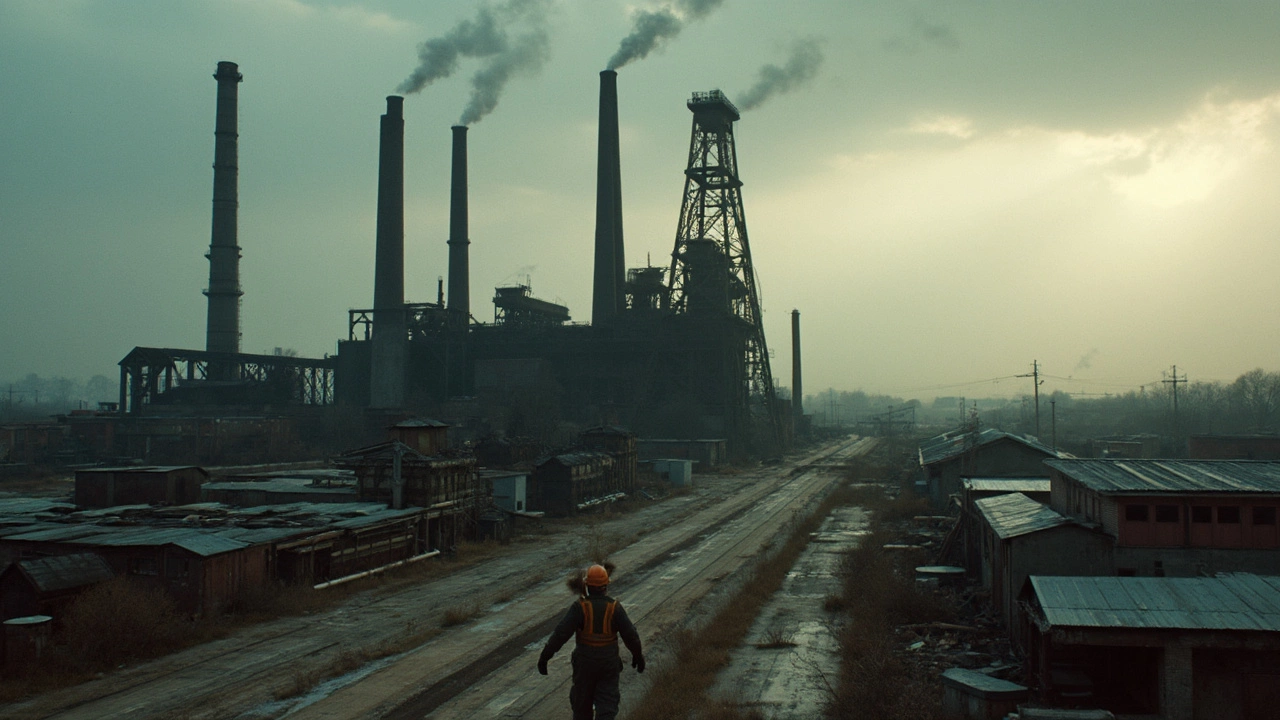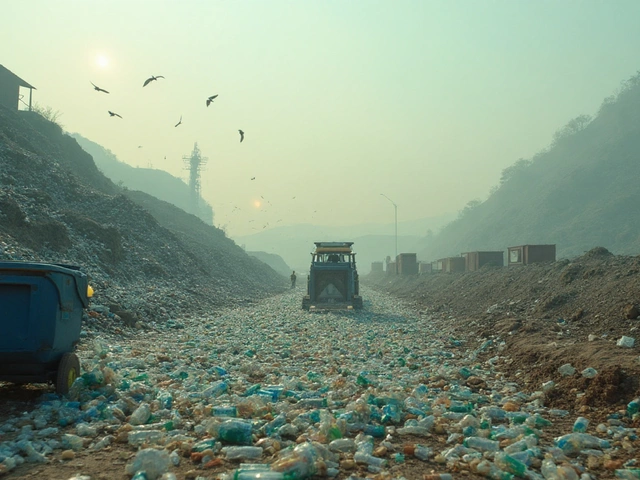Drive through towns in Pennsylvania or Ohio and you’ll spot old, rusty smokestacks in the distance—reminders of a time when US steel mills were the beating heart of local economies. Nowadays, folks are quick to ask: why doesn't the US make steel anymore?
Truth is, it’s a bit more complicated than America just giving up on steel. Years back, the US was the world champ of steel production, churning out beams for everything from skyscrapers to Minivans. Places like Pittsburgh were so tied to steel that they built their whole identity around it. Fast forward to now, most of the cheap steel you see in stores comes from places like China, India, or Turkey.
If you’re buying a grill, a car, or even just a handful of screws, odds are the steel traveled halfway around the globe. It isn’t about Americans not knowing how to make steel—it’s about dollars and cents. Plus, the world’s changed. Old-school factories couldn’t keep up with cheaper, faster production in Asia. Lower wages, fewer regulations, and modern plants overseas just made it tough for American steel to compete.
But don’t buy into the idea that America makes zero steel now. There are still US mills clinging on, making high-demand specialty steel—stuff you don’t just stamp out by the ton. These plants tend to run lean and mean with fewer workers, high-tech gear, and strict standards. Still, it’s nothing like the booming industry grandpa remembers.
- The Boom and Bust of American Steel
- Why Manufacturing Moved Overseas
- Modern Steel: Still Made in the US?
- What the Future Holds for American Steel
The Boom and Bust of American Steel
Back in the 1940s and 1950s, American steel was everywhere. Factories in places like Pittsburgh, Gary, Indiana, and Youngstown, Ohio weren't just making girders for buildings – they were the backbone of the post-war economy. If you had a family member working in a mill, they probably brought home a decent paycheck, bought a house, and supported local businesses. US steel was king, plain and simple.
Here’s just how big it got: After World War II, the US was making about 70% of the world's steel. That’s hard to even wrap your head around. Big steel companies like U.S. Steel and Bethlehem Steel were names everyone knew. The country built highways, cars, bridges, and skyscrapers taller than anyone thought possible—all from American steel.
| Year | US Steel Production (million metric tons) | Global Share (%) |
|---|---|---|
| 1950 | 87 | ~70 |
| 1970 | 120 | ~20 |
| 2023 | 80 | ~4 |
But it didn’t last. By the late 1970s, things got ugly. Cheaper imports landed on our shores, steel demand went up and down, and American mills just couldn’t keep up with slicker, more efficient plants overseas. Companies trimmed workforces, towns shrank, and those once-busy factories got quiet fast.
Some folks blame unions or government rules, but the drop-off really came from competition. Countries like Japan started using cutting-edge tech, and then China came in, undercutting prices left and right. The old mills couldn’t just press “update” and modernize overnight.
For workers and families—my own included—it was rough. People lost jobs they thought they’d keep for life. A lot of these old steel towns are still trying to bounce back. But the US steel story is a good reminder that no industry can just rest on its reputation forever.
Why Manufacturing Moved Overseas
So how did US steel lose its edge? It actually comes down to a handful of gritty reasons that walloped the industry all at once, starting in the 1970s and 80s. Back then, other countries—especially Japan and later China—made huge investments in cutting-edge factories. Their steel mills ran on newer tech, so they could crank out high-quality steel for way less money.
Wages were another blow. US steelworkers earned solid, middle-class pay, while overseas plants paid a fraction of that. And there’s more: countries like China directly supported their steel industry, keeping prices lower than American companies could ever hit. A 2023 study by the Congressional Research Service pointed out that, "Chinese steel production is now more than 10 times the US total, mainly thanks to government backing and lower operational costs."
“The collapse of steel cities like Gary and Youngstown wasn’t just about bad business decisions. It was about failing to keep up with global changes and investments elsewhere.” — John Ferriola, former CEO of Nucor Corporation
Then you've got trade deals. When the US opened up markets with NAFTA and joined the World Trade Organization, it got way easier to import cheap steel. American companies couldn’t fight off a wave of lower-priced imports, and entire plants closed almost overnight. Here’s what the numbers looked like:
| Year | US Steel Output (Million Tons) | China Steel Output (Million Tons) |
|---|---|---|
| 1980 | 101 | 37 |
| 2000 | 100 | 128 |
| 2023 | 86 | 1018 |
Red tape and rising costs in America made it even tougher. Environmental rules, healthcare, and benefits made US operations expensive, while other countries didn’t have to play by the same rulebook. Some folks blame over-engineering and slow management; others just point to the global race to the bottom for prices. The truth is, it was a mix of all these things that sent manufacturing jobs—and steel plants—out of the country.
Here’s a few key reasons at a glance:
- Lower labor and production costs overseas
- Newer, more efficient factories abroad
- Government subsidies for foreign steelmakers
- Trade policies that opened US markets to cheap imports
- Stricter US regulations raising domestic costs
All of this meant that, even if local mills wanted to compete, they just couldn’t make a profit against the flood of cheaper imported steel. That’s why so many US manufacturing jobs disappeared right along with the old smokestacks.

Modern Steel: Still Made in the US?
If you think the US doesn’t make any steel at all, that’s a myth worth busting. The US still has over 100 steel plants scattered across the country, and in 2024 alone, American mills cranked out more than 80 million tons of steel. That’s not small potatoes. But here’s where it gets interesting—most of today’s steel plants look nothing like the smoke-belching giants from the 1970s.
Today, nearly 70% of American steel comes from electric arc furnaces. These high-tech setups melt scrap metal instead of starting from raw iron ore. You’ll see this kind of plant in cities like Burns Harbor, Indiana or even right outside my hometown in Arkansas. Why the switch? It saves money, cuts pollution, and lets plants fire up or slow down way faster than old-school mills.
Big players like Nucor and Steel Dynamics lead the charge in this new wave. They target car parts, appliances, and construction beams. These companies aren’t just sweating it out to survive—they’re pumping millions into upgrades, better safety, and cleaner tech.
So is it nothing but doom and gloom for American steel? Not really. The game has changed, that’s all. Instead of massive numbers of basic steel, the US goes for higher-quality, customized products. Specialty steels for aerospace, military armor, or even the ballpark rails my kid, Arjun, loves to climb at the stadium—those are often made right here. If you care about buying American-made, look for the AISI label or ask where your steel parts come from when working on home projects.
- Electric arc furnaces now make up the bulk of US steel production.
- Places like Ohio, Indiana, and Arkansas are modern steel strongholds.
- The US specializes in top-grade, high-demand products rather than mass-market cheap steel.
If you ever wondered how the US steel scene looks today, just picture leaner, smarter, and way cleaner plants using tons of recycled scrap—and yeah, they’re still in business.
What the Future Holds for American Steel
A lot of people wonder if American steel manufacturing can make a comeback, or if things are set in stone. The answer isn’t black and white. Several trends could push the industry in new directions, and some are already shaping what comes next.
First off, cleaner and smarter mills are on the rise. New technology, like electric arc furnaces, helps US companies recycle scrap metal using less energy and fewer emissions. These eco-friendly plants cost less to run than old-school blast furnaces, and they’re popping up everywhere from Arkansas to Texas.
Another thing to watch is government policy. The US has put tariffs on cheap imported steel in past years, hoping to make homegrown steel more competitive. For example, in 2018, steel imports dropped by about 9% after tariffs hit, according to the U.S. Department of Commerce. But tariffs come with trade-offs—higher prices for everything from cars to refrigerators.
Some companies are investing in specialty steels. These are used for critical stuff like aerospace parts, wind turbines, and high-end tools. You need top-notch quality here, which is right up America’s alley.
Job-wise, the future’s a mixed bag. New steel plants are much less labor-intensive because of automation. Check this out:
| Year | US Steel Workers | US Steel Production (million tons) |
|---|---|---|
| 1980 | 399,000 | 100.4 |
| 2023 | 86,700 | 80.5 |
So while the US still produces a good chunk of steel, it does so with way fewer people, thanks to robots and new tech. That’s a tough shift for folks in old mill towns.
- If you’re planning a big project, look for steel marked “Made in USA”—you’ll know it’s up to strict standards.
- For anyone investing or job hunting in the industry, focus on companies leading the way in recycling and green steel tech.
The bottom line: American steel manufacturing won’t look anything like it did decades ago, but it’s not disappearing. It’s just evolving, relying more on smarts, technology, and new ideas than brute force and muscle.







Write a comment